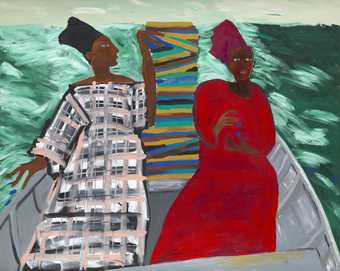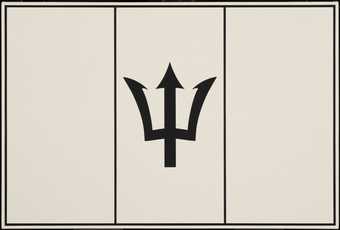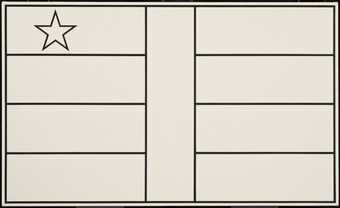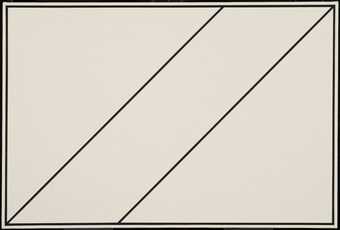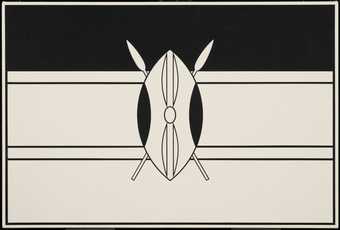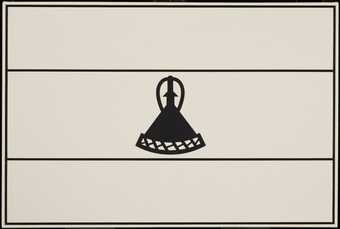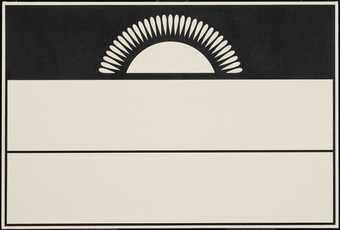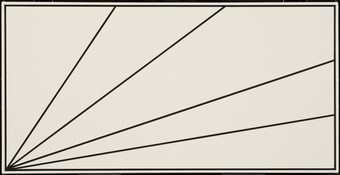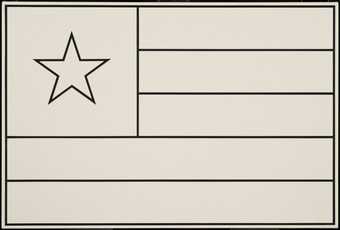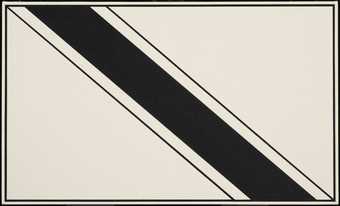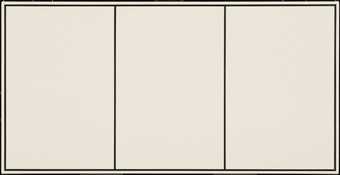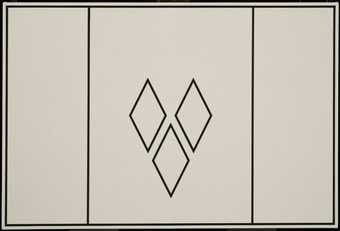
Not on display
- Artist
- Lubaina Himid CBE RA born 1954
- Medium
- Acrylic paint on canvas
- Dimensions
- Support: 1219 × 1524 mm
frame: 1291 × 1591 × 46 mm - Collection
- Tate
- Acquisition
- Presented by the artist 2009
- Reference
- T12886
Summary
Carpet 1992 is a large painting by the British artist Lubaina Himid that features overlapping blocks of bright colour rendered in thick strokes of acrylic paint. The background consists of patches painted in varying shades of blue, and is overlaid with square and rectangular forms in green, yellow, pink, red and orange. On top of a prominent red block in the left part of the composition is a black S-shaped form, and on top of an orange rectangular block in the right of the picture is painted a curving, L-shaped form in white and cream. The artist has painted small orange lines along the two shorter sides of this orange block, giving it a fringe-like edge so that it resembles a carpet, as is referred to in the work’s title.
Carpet was completed in 1992 in Preston, where Himid lives and works. It is part of a series entitled Revenge: A Masque in Five Tableaux that the artist finished in 1992 and first exhibited that same year at Rochdale Art Gallery. The series comprises twelve works (ten paintings, an installation and a drawing on paper) that includes pieces suggestive of modernist abstraction and African fabric and textiles, as seen in Carpet, and figurative works presenting pairs of black women in a range of scenarios, as in Ankledeep 1991 (Tate T12885) and Between the Two My Heart is Balanced 1991 (Tate T06947). In the catalogue for the Revenge exhibition at Rochdale Art Gallery Himid included five short poetic texts alongside images of five works from the show, reflecting the series’ subtitle A Masque in Five Tableaux. Her description of Carpet draws out the composition’s allusion to patchwork and cloth, and the idea that cloth can bear the traces of the activities for which it is used:
Patterns, colours, cloth flapping, beating in the wind. Robes wrapped against the sun and the cold of the night. Fabric highly coloured, woven, sewn together. Umbrellas tents canopies flags banners. The patterns on the cloths hold the clues to events.
(Himid in Rochdale Art Gallery 1992, p.6).
Himid was born in Zanzibar in Tanzania but moved to England shortly after her birth, and her paintings, woodcuts, installations, works on paper and curatorial projects have often emphasised the contribution of African migrants to the development of European culture. In her 1992 discussion of Himid’s Revenge series, the curator and art historian Jill Morgan outlined the possible political implications of works such as Carpet:
In Revenge, the apparently abstract paintings which read in terms of the modernist canon refer to male, abstract painting, in fact weave around the concept of fabric. The making of cloth, the creation of patterns, women’s clothing and fabric, the existence of fabric as a form of Black women’s creativity. Lubaina [Himid] has chosen fabric to be the ground, the arena for the battle with imperialism.
(Jill Morgan, ‘Women Artists and Modernism’, in Rochdale Art Gallery 1992, p.24.)
Furthermore, the artist and writer Maud Sulter argued in 1995 that the two shapes laid over the top of the coloured blocks in Carpet represent two women, and that the blocks ‘transform themselves into oriental rugs upon which two women fly winglessly’. This interpretation aligns the work with other paintings by Himid that engage with the historical liberation of women, especially black women (Sulter 1995, p.5).
In 2013 the art historian Dorothy Rowe compared the forms in Carpet to the modernist abstractions of Henri Matisse’s cut-out works, such as The Snail 1953 (Tate T00540). Rowe argues that given Matisse’s interest in African art, many pieces of which were imported to France during periods of colonial rule across the continent, Himid’s allusion to his work reflects the ways in which modern Europe is indebted both economically and artistically to Africa (Rowe 2013, pp.294–6).
Further reading
Lubaina Himid: Revenge: A Masque in Five Tableaux, exhibition catalogue, Rochdale Art Gallery, Rochdale 1992, reproduced p.7.
Maud Sulter, ‘Magic Carpet Fly: Literary Traces in the Art of Lubaina Himid’, in Beach House: Lubaina Himid, exhibition catalogue, Wrexham Library Arts Centre, Wrexham 1995, p.5, reproduced p.5.
Dorothy Rowe, ‘Retrieving, Remapping, and Rewriting Histories of British Art: Lubaina Himid’s Revenge’, in Dana Arnold and David Peters Corbett (eds.), A Companion to British Art: 1600 to the Present, Oxford 2013, pp.289–314.
Richard Martin
September 2014
Supported by Christie’s.
Does this text contain inaccurate information or language that you feel we should improve or change? We would like to hear from you.
Display caption
Carpet draws an allusion to patchwork and the idea that cloth can bear the traces of activities for which it is used. It is part of a series entitled ‘Revenge: A Masque in Five Tableaux’, comprising 12 works that blend modernist abstraction and African textiles and traditions. Himid was born in Zanzibar, a semi-autonomous part of Tanzania, but moved to England shortly after her birth. Her paintings, woodcuts, installations, works on paper and curatorial projects often emphasise the contribution of African migrants to the development of European culture.
Gallery label, September 2016
Does this text contain inaccurate information or language that you feel we should improve or change? We would like to hear from you.
Explore
- abstraction(8,615)
-
- from recognisable sources(3,634)
-
- figure(2,270)
- non-representational(6,161)
- politics and society(2,337)
- furnishings(3,081)
-
- carpet(55)
- social comment(6,584)
-
- colonialism(429)
- gender(1,689)
- migration(20)
You might like
-
Lubaina Himid CBE RA Between the Two my Heart is Balanced
1991 -
Lubaina Himid CBE RA Ankledeep
1991 -
Fred Wilson Antigua-Barbuda
2009 -
Fred Wilson Barbados
2009 -
Fred Wilson Cameroon
2009 -
Fred Wilson Central African Republic
2009 -
Fred Wilson Congo
2009 -
Fred Wilson Kenya
2009 -
Fred Wilson Lesotho
2009 -
Fred Wilson Malawi
2009 -
Fred Wilson Seychelles
2009 -
Fred Wilson Togo
2009 -
Fred Wilson Trinidad-Tobago
2009 -
Fred Wilson Nigeria
2009 -
Fred Wilson Saint Vincent-Grenadines
2009

